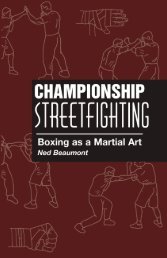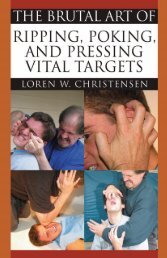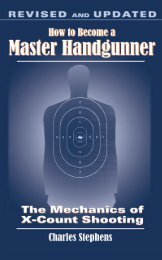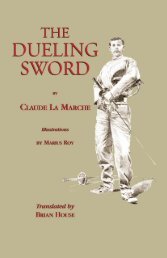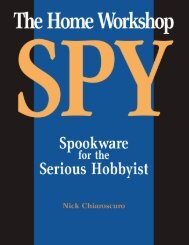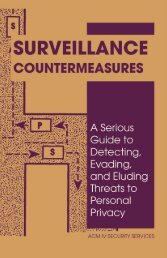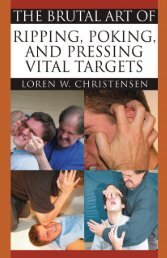Ragnar's Guide to Interviews, Investigations, and ... - Paladin Press
Ragnar's Guide to Interviews, Investigations, and ... - Paladin Press
Ragnar's Guide to Interviews, Investigations, and ... - Paladin Press
You also want an ePaper? Increase the reach of your titles
YUMPU automatically turns print PDFs into web optimized ePapers that Google loves.
RAGNAR’S GUIDE TO INTERVIEWS, INVESTIGATIONS, AND INTERROGATIONS<br />
novice investiga<strong>to</strong>r used <strong>to</strong> put a very small pebble in his<br />
shoe. Every time he stepped on the pebble he reminded himself<br />
<strong>to</strong> observe br<strong>and</strong>s of cigarettes or cigars, booze, watches,<br />
br<strong>and</strong>s of suits, colors of vehicles, condition of clothes,<br />
h<strong>and</strong>s, hats, shoes, <strong>and</strong> whatever else. Soon it was such fun<br />
<strong>and</strong> he was sufficiently conditioned that he removed the<br />
s<strong>to</strong>ne. But he found he also had <strong>to</strong> continually remind himself<br />
<strong>to</strong> listen as well as observe.<br />
Sir Arthur Conan Doyle in “A Sc<strong>and</strong>al in Bohemia,” a<br />
short s<strong>to</strong>ry in The Adventures of Sherlock Holmes, used the<br />
example of Watson’s not knowing the number of steps that<br />
led from one room <strong>to</strong> another <strong>to</strong> show how unobservant<br />
most people are.<br />
“When I hear you give your reasons,” [Watson]<br />
remarked, “the thing always appears <strong>to</strong> me <strong>to</strong> be so<br />
ridiculously simple that I could easily do it myself,<br />
though at each successive instance of your reasoning<br />
I am baffled until you explain your process. And<br />
yet I believe that my eyes are as good as yours.”<br />
“Quite so,” [Holmes] answered, lighting a cigarette,<br />
<strong>and</strong> throwing himself down in<strong>to</strong> an armchair.<br />
“You see, but you do not observe. This distinction<br />
is clear. For example, you have frequently seen the<br />
steps which lead up from the hall <strong>to</strong> this room.”<br />
“Frequently.”<br />
“How often?”<br />
“Well, hundreds of times.”<br />
“How many are there?”<br />
“How many? I don’t know.”<br />
“Quite so! You have not observed. And yet you<br />
have seen. That is just my point. Now, I know that<br />
there are seventeen steps, because I have both<br />
seen <strong>and</strong> observed.”<br />
24



